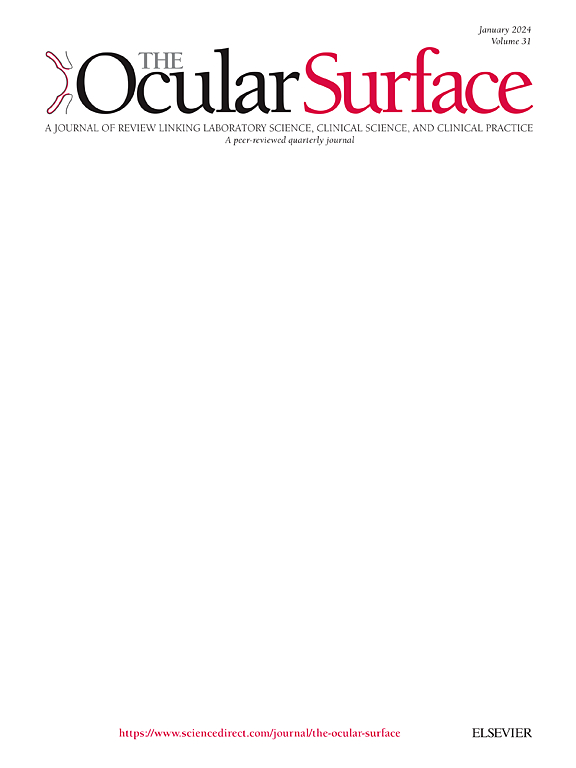Retinoic acid promotes conjunctival epithelium differentiation and goblet cell regeneration: evidence from novel 3D conjunctival organoids and whole-mount PAS staining
IF 5.6
1区 医学
Q1 OPHTHALMOLOGY
引用次数: 0
Abstract
Purpose
To investigate the differentiation effects of retinoic acid on primary conjunctival epithelium using both 2D and 3D models, and to evaluate its in vivo effects on conjunctival epithelium and goblet cells in mice using a novel goblet cell assessment method.
Methods
The differentiation effects of retinoic acid were evaluated in vitro using 2D culture and 3D organoid models. Under 2D conditions, differentiation was assessed using qRT-PCR, light microscopy, immunofluorescence staining, and Western blot analysis for goblet cell markers. In the 3D organoid model, differentiation was confirmed using qRT-PCR, immunofluorescence staining, and AB-PAS staining. In vivo, a novel goblet cell assessment method—whole-mount PAS staining—was introduced, along with H&E staining to evaluate the effects of retinoic acid eye drops.
Results
In the 2D culture model, retinoic acid induced cell fusion, decreased stemness marker expression, and increased goblet cell differentiation markers. In the 3D organoid model, retinoic acid treatment led to elevated expression of goblet cell markers, including Muc5ac, Tff1, and Gcnt3, as confirmed by qRT-PCR, AB-PAS staining, and immunofluorescence. In vivo, retinoic acid eye drops promoted goblet cell generation, as demonstrated by the novel assessment method.
Conclusions
Retinoic acid promotes conjunctival epithelial differentiation and goblet cell regeneration both in vitro and in vivo. A novel method for goblet cell detection is proposed, providing a more accurate and reliable approach for evaluating conjunctival goblet cells in future research.
维甲酸促进结膜上皮分化和杯状细胞再生:来自新型三维结膜类器官和全载PAS染色的证据
目的采用二维和三维模型研究维甲酸对小鼠原代结膜上皮细胞的分化作用,并采用一种新的杯状细胞评价方法,评价维甲酸对小鼠结膜上皮细胞和杯状细胞的体内影响。方法采用体外二维培养和三维类器官模型评价维甲酸的体外分化作用。在二维条件下,使用qRT-PCR、光镜、免疫荧光染色和杯状细胞标记物的Western blot分析来评估分化。在三维类器官模型中,采用qRT-PCR、免疫荧光染色和AB-PAS染色证实分化。在体内,引入了一种新的杯状细胞评估方法-全载PAS染色,以及H&;E染色来评估视黄酸滴眼液的效果。结果在二维培养模型中,维甲酸诱导细胞融合,降低干性标志物表达,增加杯状细胞分化标志物表达。在3D类器官模型中,经qRT-PCR、AB-PAS染色和免疫荧光证实,维甲酸处理导致杯状细胞标记物Muc5ac、Tff1和Gcnt3的表达升高。在体内,维甲酸滴眼液促进杯状细胞的生成,这一新的评估方法证实了这一点。结论维甲酸对体外和体内结膜上皮细胞分化和杯状细胞再生均有促进作用。提出了一种新的杯状细胞检测方法,为今后结膜杯状细胞的检测提供了一种更准确、更可靠的方法。
本文章由计算机程序翻译,如有差异,请以英文原文为准。
求助全文
约1分钟内获得全文
求助全文
来源期刊

Ocular Surface
医学-眼科学
CiteScore
11.60
自引率
14.10%
发文量
97
审稿时长
39 days
期刊介绍:
The Ocular Surface, a quarterly, a peer-reviewed journal, is an authoritative resource that integrates and interprets major findings in diverse fields related to the ocular surface, including ophthalmology, optometry, genetics, molecular biology, pharmacology, immunology, infectious disease, and epidemiology. Its critical review articles cover the most current knowledge on medical and surgical management of ocular surface pathology, new understandings of ocular surface physiology, the meaning of recent discoveries on how the ocular surface responds to injury and disease, and updates on drug and device development. The journal also publishes select original research reports and articles describing cutting-edge techniques and technology in the field.
Benefits to authors
We also provide many author benefits, such as free PDFs, a liberal copyright policy, special discounts on Elsevier publications and much more. Please click here for more information on our author services.
Please see our Guide for Authors for information on article submission. If you require any further information or help, please visit our Support Center
 求助内容:
求助内容: 应助结果提醒方式:
应助结果提醒方式:


